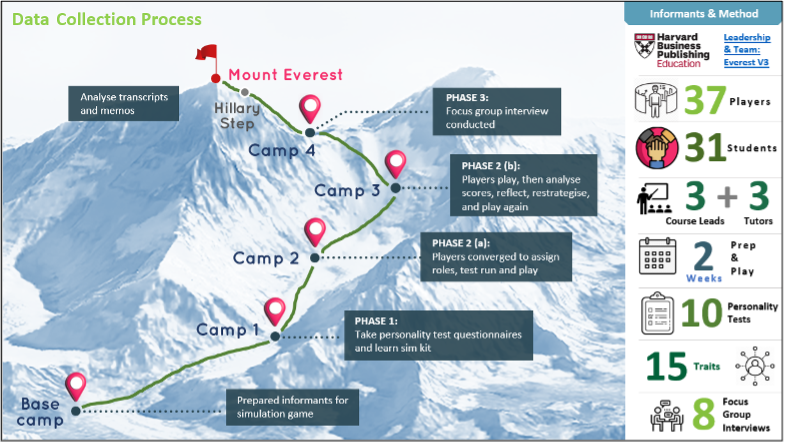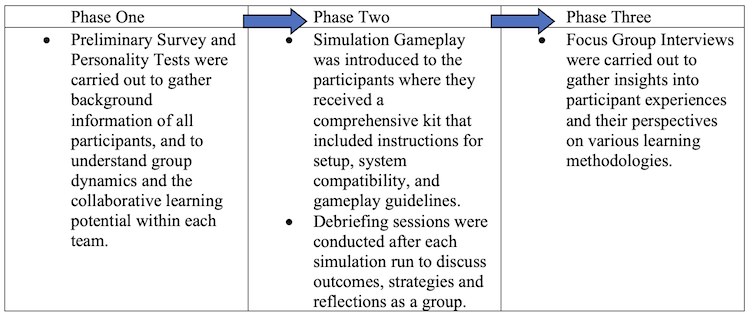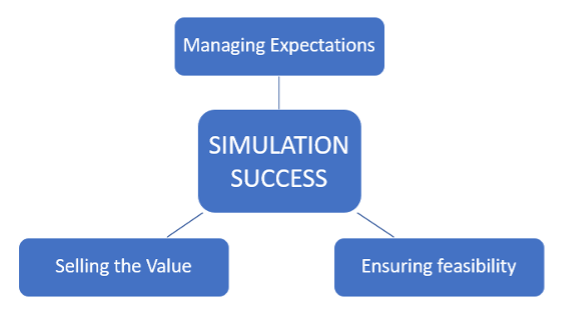
2024 VOL. 11, No. 2
Abstract: Simulation-based learning has the potential to foster a transformative learning culture within the Open and Distance Learning (ODL) environment. This report is based on a research project, integrating a simulation into a digital ODL classroom, conducted in Wawasan Open University, an ODL university in Malaysia. The report highlights how a simulation can be valuable to ODL students as an effective learning tool and by creating an immersive learning experience for the students.
Keywords: Everest Team simulation, Open and Distance Learning (ODL), student engagement
Digitisation, quickened by the recent pandemic, has prompted the integration of technology into education, and demanded both instructors and students adapt (Capuyan et al., 2021). Moreover, instructional methods must also evolve to accommodate the changing learning styles of current university students (Blackford & Shi, 2015), with simulation games emerging as a promising strategy (Peters & Stamp, 2021). Online simulations, widely integrated into higher education, offer real-time, hands-on experiences facilitating better conceptual understanding and practical skill acquisition (Peters & Stamp, 2021).
Simulation as a teaching technique, reproduces situations in complex computer-aided interactive systems, and allows students to deal in a realistic way with matters of vital concern but without dire consequences should they make wrong choices (Encyclopedia Britannica, 2023). Specifically, as stated in Kolb's (1984) experiential learning cycle, students, through simulations, learn, relearn, reflect, and create knowledge from their experiences. A research project based on a business simulation was recently conducted to explore its impact across various disciplines in an open and distance learning (ODL) university, focusing on Mount Everest-themed challenges to foster critical thinking, agility, and soft-skills development in communication and collaboration, teamwork and adaptability. Its outcomes cut across various student backgrounds and academic levels. Therefore, this report highlights lessons learnt from the research project, which could provide significant insights to other education practitioners intending to strategically incorporate simulation in the teaching and learning process within an ODL environment.
Globally, working adults are increasingly choosing ODL, because of its flexibility and accessibility, enabling them to manage their diverse responsibilities. Nevertheless, there are various challenges related to ODL, such as decreased student motivation (due to limited face-to-face personal interactions with tutors, peers or content), high initial costs, and inadequate support (Dzakiria et al., 2013). To address these challenges, ODL universities must enhance interactivity within the student-tutor-content relationship. Furthermore, the demands of Industrial Revolution 4.0 (and beyond) significantly change the requirements of graduate attributes. Consequently, the key to cultivate and engage students in learning, as well as to continually keep up with changing work demands is to find teaching techniques and approaches that fit the requirements.
Extant studies have indicated that simulations have the potential for ODL instructors to create immersive and interactive environments that foster active participation and effective communication (Beaudry, 2016; Buil et al., 2020; Caruso, 2019; Chernikova et al., 2020). Under such conditions, the gap between distance learning and meaningful real-life collaborative experiences can be bridged, enhancing the overall learning experience for distance learners. Instructors usually incorporate simulations as part of class delivery (Nichols & Wright, 2015). They teach the students how to navigate the dashboard, provide a briefing before the session begins, and apply the outcome of the simulation to debrief the students or get students to reflect on the simulated experiences in relation to identified theories or concepts. To maintain practicality, instructors require all students to be seated in a classroom so as to technically assist them with navigation, since the simulation runs in real-time.
However, in an ODL context, running a simulation online with remote students requires the instructor-cum-facilitator to assist individual students online, personally, with technical assistance and, simultaneously, to follow the progress of the real-time simulation. This situation clearly depicts the whole difficulty of administering real-time simulations in ODL. Furthermore, in ODL universities, it is not a straightforward process to insert simulations into courses as part of an ODL learning and teaching strategy. Adopting new and innovative ODL learning tools, such as a simulation, requires time and effort to produce supplementary and complementary teaching-learning materials for both students and instructors. Comprehensive understanding of the simulation context, navigation and decision-making mechanics, results interpretation, technical troubleshooting and other issues by all parties involved determine the success of running a simulation in a digital classroom. Thus, by bringing simulations into the ODL environment, there are concerns about transitioning the use of simulations into digital classrooms and managing suitable delivery for ODL students. This research project aimed at addressing the relevant challenges and concerns within this context.
This research project was conducted at Wawasan Open University. The recruited research participants (known in the simulation context as “players”) had ODL teaching or learning experience. However, they did not have any prior online simulation-based learning experience.
The simulation used (see Figure 1) was the “Harvard Business Publishing Leadership and Team Simulation: Everest V3”, a highly regarded and trusted resource utilised in business education, specifically for instructing leadership and team management principles within a simulated dramatic expedition setting of Mount Everest (Roberto & Edmondson, 2017). Briefly, each climbing team comprised five members playing the roles of leader, marathoner, photographer, environmentalist, and physician, striving to reach the summit of Mount Everest. Additional members can act as observers. A team observer usually notes member interaction dynamics and pays attention to subtle cues during a run. These notes are used to gain further insights during a simulation evaluation, enriching discussions during the debrief. Two out of the seven teams in this research included the observer role. The simulated experience spanned six virtual days, encompassing the ascent through five camps and demanding approximately one and a half hours of active participation. Each round of play requires collective deliberation among team members on whether to proceed to the next camp along the route to the peak. During the simulation, players/participants engaged in the analysis of critical information regarding weather conditions, health status, available supplies, set objectives, and hiking pace, deliberating on the extent of information to share with their team members. Additionally, the team faced three undisclosed challenges along the journey, prompting them to make consequential decisions impacting their climbing progress, overall health, and ultimate success.

There were 37 participants, including 31 students and six academics. The participants were ODL students (undergraduates and postgraduates) and academics (course leaders and tutors). In general, the ODL students were from a vast background, ranging from school leavers to older professionals. They varied in age and generational cohorts. The academics ranged from individuals with minimal industry experience to those with senior positions in the industry. The research project was conducted in three phases (see Table 1).
Table 1: Research Project Phases

The simulation research project highlighted several key lessons surrounding students’ and academics’ receptiveness towards a new teaching and learning approach and the use of technology application in learning as follows.
Both ODL students and academics expressed concerns about the time and effort required for preparation and implementation of simulation-based learning. Academics were particularly cautious as they were forced to step outside their comfort zones of traditional ODL teaching and facilitation skills. They required more time to familiarise themselves with the simulation and to consider the alignment of simulation outcomes with the course learning objectives within the limited lecture time. On the other hand, students adopted a more experimental approach, trying to determine if the time invested in simulations would be as beneficial as time spent in traditional lessons.
Simulation-based learning effectively caters to the preferences of ODL students who seek practical applications in their studies. By connecting theoretical knowledge and real-world application, this approach enabled students to reflect on their learning experiences and improve their skills and knowledge effectively. It also enabled academics to assess students’ understanding and intervene where needed promptly. This approach is particularly beneficial for ODL students who study independently and remotely.
ODL students usually need more opportunities for networking and forming peer relationships. However, simulation runs increased engagement and interactions among students. The dynamic interactions to solve embedded challenges during simulation tasks encouraged the collaboration and consensus-building needed to improve personal and team performance. The students also developed a sense of community applicable to other learning contexts.
By leveraging their industry knowledge and experiences during simulation-based learning, ODL students and academics can enhance their understanding of course content. Despite initial challenges in designing the course and navigating the simulation, academics focused on ensuring that students valued the experience and developed practical skills transferable to real-world situations, thus bridging the gap between theory and practice. During a debrief, the three most common takeaways on transferable skills included:
Players also stated that the simulation helped them recognise critical leadership traits such as ‘listening’ (a chat box on the simulation screen functions as a walkie-talkie for the players) and asking the right questions, knowing how to read the room, being agile, when to be firm and how to be more attuned to members’ feeling to build team cohesiveness.
Simulation-based learning should be strategically integrated into courses. Considerations should include selecting appropriate courses where simulations can be most effectively applied, alignment with learning outcomes, development of specific skill sets, group dynamics, and timing within the course of study. The financial implications, such as simulation software and implementation costs, must be rationalised to accommodate both academic and student concerns, in particular, if these costs might be transferred to programme fees.
Despite concerns of repetition, ODL students and academics found the simulations valuable, regardless of the programmes they were involved in. The replicability of the simulation enabled the development of transferable skills and attributes across various disciplines that are essential for students’ future careers. However, carefully aligning learning outcomes across multiple courses and disciplines that use the same simulation is crucial to avoid redundancy and ensure continued engagement and learning progress.
The Centre for ODL Experiences (COLE) designers at Wawasan Open University are exploring the simulation in this study and other types of simulation to find a fit for digital learning and learning platforms. Based on lessons learnt from the research project, other educational practitioners need to address concerns and optimise the benefits of implementing simulation-based learning to ensure its effective integration within the broader teaching and learning strategy of a university. The success of future simulation-based learning activities requires attention to three things (see Figure 2).

Firstly, managing expectations involves clearly defining the anticipated outcomes and benefits for students and academics. Educators must communicate the specific skills and knowledge that students can expect to gain from engaging with simulations and set realistic goals and objectives that align with the broader course curriculum. This clarity helps mitigate any misconceptions and ensures that both parties are aware of the learning journey ahead.
Secondly, selling the value of simulations involves emphasising their practical relevance and the direct impact on student academic and professional development. For instance, when the facilitator applied the concept of confirmation bias in decision-making during debriefing, both student and academic participants could immediately recall critical incidents during their respective simulation runs to relate to where and how such biases occurred, which led to decision groupthink. Participants also built appreciation toward workplace values such as team diversity and team camaraderie, amongst others. Even challenges in administering simulation runs became lessons useful to apply at the workplace. Team members who were more tech-savvy and had diligently gone through the player’s kit demonstrated their readiness by navigating the dashboard more effectively and making timely decisions. Educators must highlight how simulations can bridge the gap between theoretical concepts and real-world applications while also fostering critical thinking, problem-solving, and collaboration skills that are essential for future career success. When students are convinced of the value of simulations, they will actively participate and invest in the learning process.
Lastly, ensuring feasibility involves assessing the practical and logistical aspects of integrating simulations into the existing curriculum. Specifically, it involves evaluating the resources, time, and technical support required for the successful implementation of simulations. Educators should conduct thorough feasibility studies to determine whether their university has the necessary infrastructure, technology, and financial capacity to support the integration of simulations in learning. By addressing any potential challenges and ensuring the availability of adequate resources, educators can create a conducive environment for the seamless adoption and utilisation of simulations as an effective educational tool.
Acknowledgement: This work was supported by the Centre for Research and Innovation, Wawasan Open University grant [WOU/CeRI/2021(0036)]. The authors would also like to thank the Centre for ODL Experiences and Jasmine Emmanuel, who were involved in the simulation research project.
Beaudry, S.L. (2016). Summiting Mount Everest: An experiential learning application for organizational behavior. Developments in Business Simulation and Experiential Learning: Proceedings of the Annual ABSEL Conference, 43. https://doi.org/10.1177/1052562912459947
Blackford, B., & Shi, T. (2015). The relationship between business simulations in capstone management courses and standardized test scores. The International Journal of Management Education, 13(1), 84-94. https://doi.org/10.1016/J.IJME.2015.01.005
Encyclopaedia Britannica. (2023, December 20). Simulation. Encyclopedia Britannica. https://www.britannica.com/science/simulation
Buil, I., Catalán, S., & Martínez, E. (2020). Engagement in business simulation games: A self‐system model of motivational development. British Journal of Educational Technology, 51(1), 297-311. https://doi.org/10.1111/bjet.127624
Capuyan, D.L., Capuno, R.G., Suson, R.L., Malabago, N.K., Ermac, E.A., Demetrio, R.A.M., Aburayya, A.M., Concordio, C.T., Arcadio, R.D., Medio, G.J., & Lumantas, B.C. (2021). Adaptation of innovative edge banding trimmer for technology instruction: A university case. World Journal on Educational Technology: Current Issues, 13(1), 31-41. https://doi.org/10.18844/WJET.V13I1.5361
Caruso, J.V. (2019). Using business simulations to prepare students to think critically, make better decisions, and solve business problems: Developments in business simulation and experiential learning. Proceedings of the Annual ABSEL Conference, 46. https://absel-ojs-ttu.tdl.org/absel/index.php/absel/article/view/3244
Chernikova, O., Heitzmann, N., Stadler, M., Holzberger, D., Seidel, T., & Fischer, F. (2020). Simulation-based learning in higher education: A meta-analysis. Review of Educational Research, 90(4), 499–541. https://doi.org/10.3102/0034654320933544
Dzakiria, H., Kasim, A., Mohamed, A.H., Christopher, A.A. (2013). Effective learning interaction as a prerequisite to successful open distance learning (ODL): A case study of learners in the northern state of Kedah and Perlis, Malaysia. Turkish Online Journal of Distance Education, 14(1), 111-125. https://files.eric.ed.gov/fulltext/EJ1006252.pdf
Kolb, D. (1984). Experiential learning as the science of learning and development. Prentice Hall.
Nichols, E., & Wright, A.L. (2015). Using the Everest team simulation to teach threshold concepts. Journal of Management Education, 39(4), 531-537. https://doi/org/10.1177/1052562915571937
Peters, T.D., & Stamp, P.L. (2021). The virtual workplace: The impact of embedding business simulations into classroom culture. Journal of Education for Business, 96(6), 373-380. https://doi.org/10.1080/08832323.2020.1838411
Roberto, M.A., & Edmondson, A.C. (2017). Leadership and team simulation: Everest V3. Harvard Business Publishing Education. https://hbsp.harvard.edu/product/8867-HTM-ENG
Author Notes
https://orcid.org/0000-0003-0461-9954
https://orcid.org/0000-0002-1689-055X
Dewi Amat Sapuan is an Associate Professor of Organisational Behaviour, and leads the Centre for ODL Experiences at Wawasan Open University, She is a chartered manager and has a deep research interest in the paradox of human experience and human development learning. Dewi is currently pursuing a master’s degree in criminology and penology. Email: dewisapuan@wou.edu.my
Josephine Ie Lyn Chan is a research fellow at Wawasan Open University. Her research interests include strategic management, organisational performance, and creative teaching and active learning. Besides teaching and conducting research, Josephine is a qualified quality, environmental, and occupational safety and health management systems auditor. Email: josephinechan@wou.edu.my
Cite as: Sapuan, D.A., & Chan, J.I.L. (2024). Exploring simulation for immersive learning experience in the digital, open, and distance classroom. Journal of Learning for Development, 11(2), 382-389.